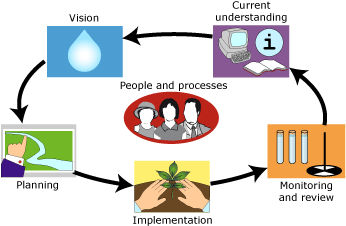The Environmental Management Framwork has six components. Each component constitutes a logical step in the framework, and comprises a focused activity with clear outputs. Brief descriptions of the different components can be viewed by rolling you mouse over the icons in the image below.

People and processes
Good communication between scientists, managers and the people who use waterways helps build the knowledge of all stakeholders, and allows options for management solutions to be scoped, agreed and more easily implemented.
Community involvement
Capacity building
Different water quality frameworks
- The National Water Quality Management System framework
- Frameworks under the NAP and NHT
- Linking the frameworks
Critical success factors
Current understanding
Documenting the current knowledge and understanding of your catchment and waterways is fundamental to all components of the water quality management framework. Information from stakeholders is pooled with on-going research. This helps define the broader context of the water quality issues. Understanding of the natural and social systems is refined and knowledge gaps are identified. This knowledge is continually updated by new information (adaptive management). For example, the detailed quantitative assessments in the ‘planning’, ‘implementation’ and ‘monitoring and review’ components of the framework will eventually become part of current understanding.
A simple approach to water quality issues
The scope of your water quality management strategy
Information for your waterway
Conceptualise your waterway
- Create a conceptual diagram of your waterway
Vision
This step focuses on identifying the stakeholders’ vision and aspirations for the catchment and its waterways. This then allows more specific environmental management goals and water quality objectives/targets to be specified based on the aspirational values and uses of the waterways.
Environmental values
- What are environmental values?
- How do you determine draft environmental values?
- What environmental values already exist?
Environmental management goals
Indicators
- What are indicators?
- What types of indicators are there?
- How do you select indicators?
- Information on coastal indicators
Guidelines
- What are water quality guidelines?
- How do you develop guidelines?
- Where can you find guidelines for environmental values?
Water quality objectives
Planning
Planning is where management actions to protect waterways and address the ’causes’ of water pollution are devised, and social, economic and ecological impacts are evaluated to negotiate and define a preferred strategy. A range of techniques are used to assess impacts and prioritise solutions.
Alternative management strategies
Impacts of your management strategies
Decision-making
Are the impacts of your strategy acceptable
YES – Continue to Implementation
No – Revise your vision and re-evaluate
Implementation
This step focuses on the implementation of the agreed necessary actions with the assignment of agreed roles and responsibilities.
Implementing your strategy
Monitoring and review
Following the decision to implement a water quality management strategy, it is essential to monitor and review all component of the strategy, including checking the effects of the strategy against the agreed environmental values, management goals and water quality objectives.


